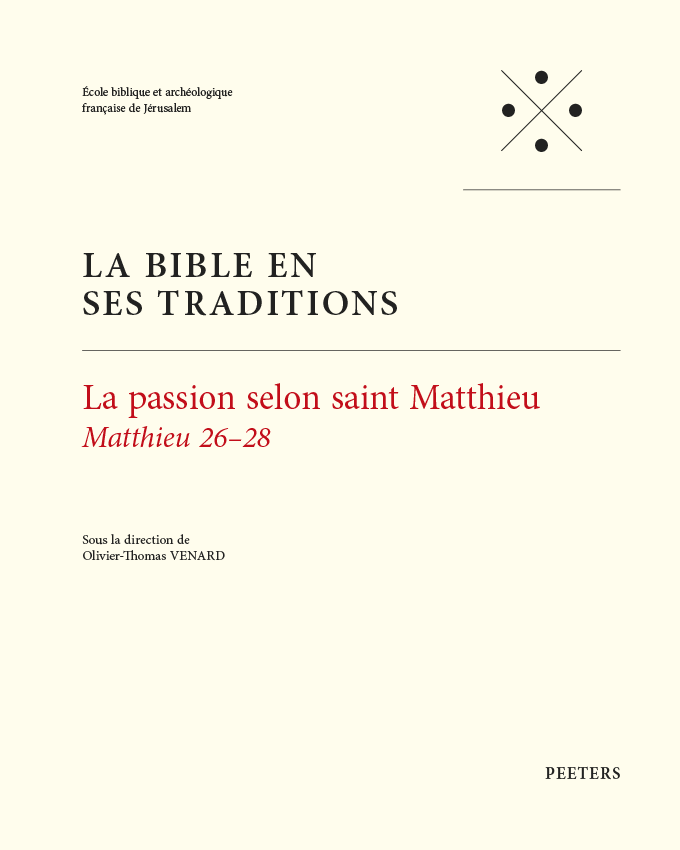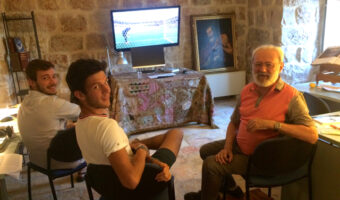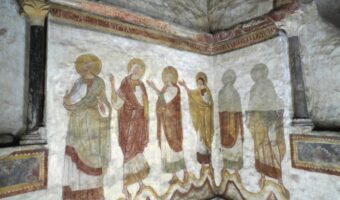Two beautiful volumes, containing over a thousand pages of information, analysis and reflection!
With great gratitude for the competence and patience of more than sixty contributors who have made it possible to produce the work in a dozen years – but also for that of Dr. Bieke Mahieu, our scientific editor, and our friends (+) Paul, Luc and Stéphanie Peeters – we have finally brought this monumental achievement to light, in the world of printed books.
A pioneer in the adventure of The Bible in its Tradition, this project explores the possibilities and difficulties raised by our annotation grid, which is complete but not exhaustive, more conducive to meticulous analysis than to daring synthesis, but open to all sorts of discoveries, even in the history of dance and the cinema…
We owe him a large thanks for his part of the Jesus’ Dictionary, many of whose entries derive directly from the work of the Passion team.
The Passion According to Matthew: Matthew 26-28
COLLECTION: La Bible en ses Traditions, 4
EDITOR: Venard O.-T.
SUMMARY: “The Passion according to St. Matthew”: under this title, which is that of several masterpieces of Western art, here are the last three chapters of the first canonical gospel, on which the pilot team of The Bible in its Traditions has worked for more than ten years. This book deals not only with the passion itself (Mt 26-27), but also with the compilation of testimonies of encounters with the Risen One that flank it (Mt 28).
Entirely re-translated, the text is commented on, as in the Glosis, in the form of analytical notes around the verses, or brief summaries listed in the second volume. The annotation describes the richness of the text, from its variants to its enunciative and narrative structures, including its lexicon and grammar. It also explores the context, in order to refine the historical approach, in particular thanks to information coming from the scholarly re-appropriation of the Gospels as part of the Jewish literature of the so-called “Second Temple” period. Finally, it outlines the reception of the Gospels across disciplines and ages.By choosing a text with an immense posterity, multiform and full of artistic treasures, the team wished to experiment with the hermeneutic model of The Bible in its Traditions in all directions, including the most unexpected, such as dance. The rich investigation reported here shows that the history of the reception of the Gospel determines its meaning at least as much as the historical questions it raises. The inventory of interpretations is not a “decorative” discipline of lesser importance than its philological or historical study, nor of lesser seriousness than its properly religious use. Indeed, the very constitution of the Gospel text was already an act of reception, and its scientific study, however objective it may be, is also indebted to numerous preconceptions, of which openness to other disciplines, including the arts, makes it possible to become aware.
Not everything is printed: many extracts from ancient and modern authors, and many of the works of art examined in the course of this research, are not included in the present book. To discover them in the digital version of our research, readers should visit bibletraditions.org. Numerous multimedia notes present visual and musical works of art to contemplate, as opportunities to continue rediscovering this founding text, from unnoticed textual details to its most unexpected theological meanings.
These two volumes thus open up like a rich quarry of cut and arranged stones… ready for new elaborations.
In addition to our meeting at the S.B.L. Annual Session in San Antonio (TX, U.S.A.) on 23 November, “How To Connect Exegesis with Reception History? Just Do It!”, with a response by Mark W. Eliott, St Andrew’s University,
our Passion was presented locally in Jerusalem at the Academic Council of the École Biblique and at a meeting of the Ecumenical Theological Research Fraternity in Israel, 15 December 2021 …
Several colleagues have already agreed to receive the book and prepare reviews: we thank them in advance!




